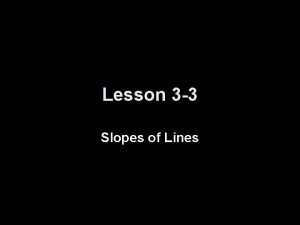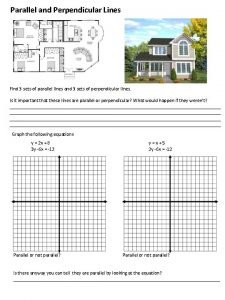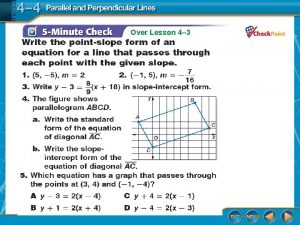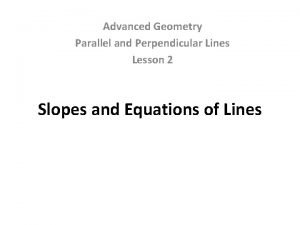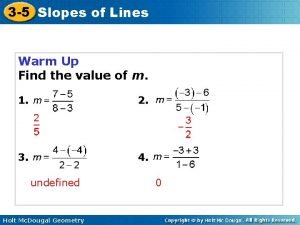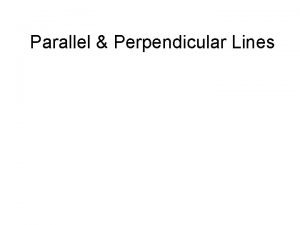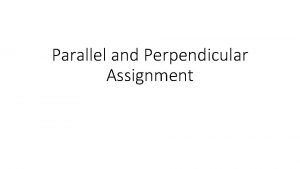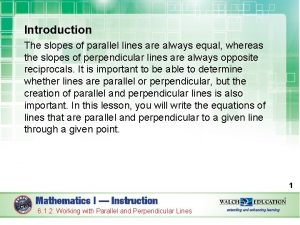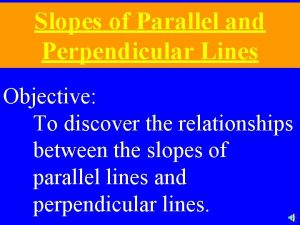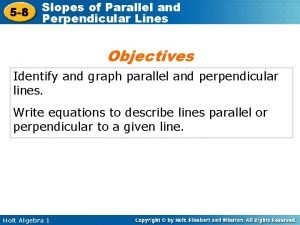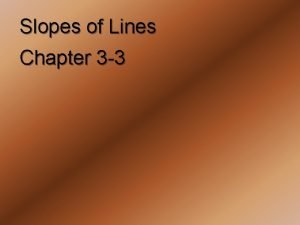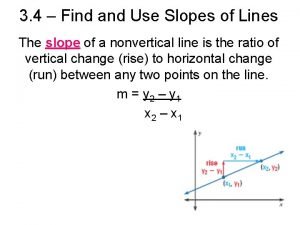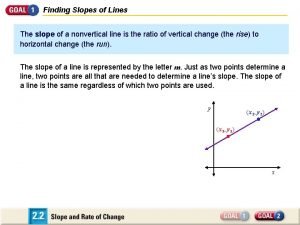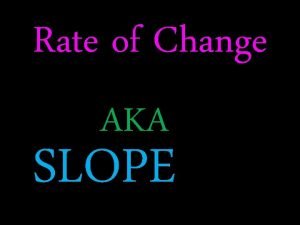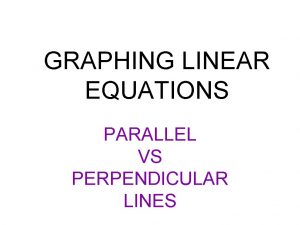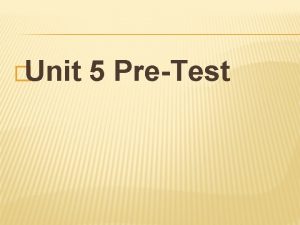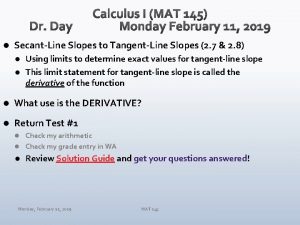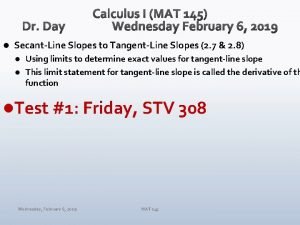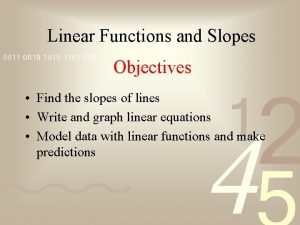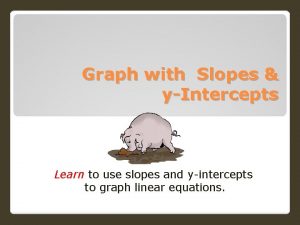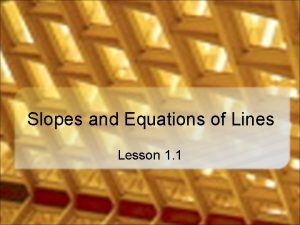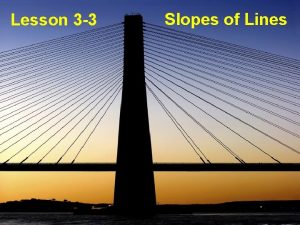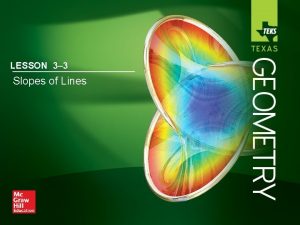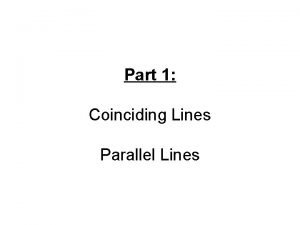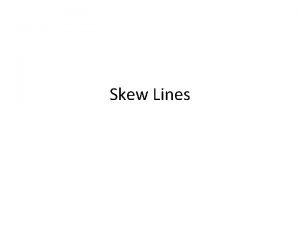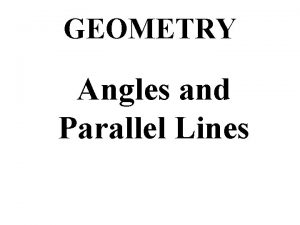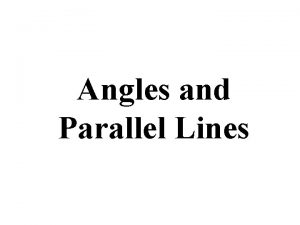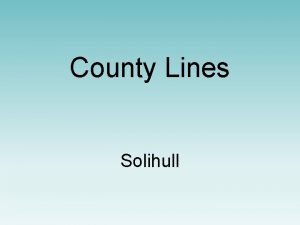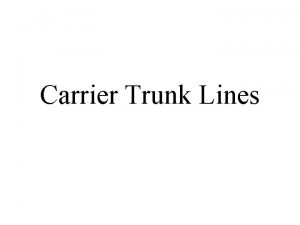Lesson 3 3 Slopes of Lines Transparency 3




















- Slides: 20

Lesson 3 -3 Slopes of Lines

Transparency 3 -3 5 -Minute Check on Lesson 3 -2 In the figure, m 4 = 146. Find the measure of the following angles. 1. 2 146 2. 7 34 3. 10 146 4. 11 34 5. Find m 11 + m 6 6. 180 In the figure to the right what is the measure of ABC? Standardized Test Practice: A 77 B 84 C 89 D 91

Objectives • Find slopes of lines • Use slopes to identify parallel and perpendicular lines

Vocabulary • Slope – symbol m; the vertical rise divided by the horizontal run (or m = y/ x) A horizontal line has a slope of zero (no change in y; y = 0) A vertical line has an undefined slope (no change in x; x = 0) • Rate of change – describes how a quantity changes over time

Postulates • 3. 2 – Two non-vertical lines have the same slope if, and only if, they are parallel. • 3. 3 – Two non-vertical lines are perpendicular if, and only if, the product of their slopes is -1.

Review of Slopes • Slope, m, is a rate of change (∆y / ∆x) between two points (x 1, y 1) and (x 2, y 2) y y 2 – y 1 ∆y m = -----x 2 – x 1 ∆x x • Two lines are parallel (never intersect), if they have the same slope (myellow = 1) • Two lines are perpendicular (forms a right angle), if their slopes multiply together to get -1 (mpink = -1)

Find the slope of the line. From (– 3, 7) to (– 1, – 1), go down 8 units and right 2 units. Answer: – 4

Find the slope of the line. Use the slope formula. Let be be . and Answer: undefined

Find the slope of the line. Answer:

Find the slope of the line. Answer: 0

a. Find the slope of the line. Answer:

b. Find the slope of the line. Answer: 0

c. Find the slope of the line. Answer: 2

d. Find the slope of the line. Answer: undefined

RECREATION For one manufacturer of camping equipment, between 1990 and 2000, annual sales increased by $7. 4 million per year. In 2000, the total sales were $85. 9 million. If sales increase at the same rate, what will be the total sales in 2010? Slope formula

Simplify. Multiply each side by 10. Add 85. 9 to each side. The coordinates of the point representing the sales for 2010 are (2010, 159. 9). Answer: The total sales in 2010 will be about $159. 9 million.

Determine whether and perpendicular, or neither. are parallel, Answer: The slopes are not the same, The product of the slopes is are neither parallel nor perpendicular.

Determine whether and perpendicular, or neither. are parallel, Answer: The slopes are the same, so are parallel.

Determine whether and perpendicular, or neither. a. Answer: perpendicular b. Answer: neither are parallel,

Summary & Homework • Summary: – The slope of the line is the ratio of its vertical rise to its horizontal run – Parallel lines have the same slope – Perpendicular lines have slopes whose product is -1 (also known as negative inverses) • Homework: pg 142 -143: 15, 16, 19, 20, 25, 27, 29, 30
 3-3 slopes of lines answer key
3-3 slopes of lines answer key 3 sets of parallel lines
3 sets of parallel lines Slopes of parallel and perpendicular lines lesson 8-1
Slopes of parallel and perpendicular lines lesson 8-1 Lesson 2-4 slopes of parallel and perpendicular lines
Lesson 2-4 slopes of parallel and perpendicular lines 3-5 slopes of lines
3-5 slopes of lines Parallel slope formula
Parallel slope formula Parallel and perpendicular lines worksheet doc
Parallel and perpendicular lines worksheet doc Slopes of parallel and perpendicular lines assignment
Slopes of parallel and perpendicular lines assignment Parallel lines slope
Parallel lines slope Two lines are parallel if their slopes are
Two lines are parallel if their slopes are 8-1 slopes of parallel and perpendicular lines
8-1 slopes of parallel and perpendicular lines 3-3 slopes of lines
3-3 slopes of lines Find and use slopes of lines
Find and use slopes of lines Slopes of lines
Slopes of lines 4 types of slope
4 types of slope Oversteepening of slopes
Oversteepening of slopes Parallel vs linear
Parallel vs linear Emigree poem summary
Emigree poem summary Living space poem
Living space poem Slopes
Slopes Whats a slope
Whats a slope
